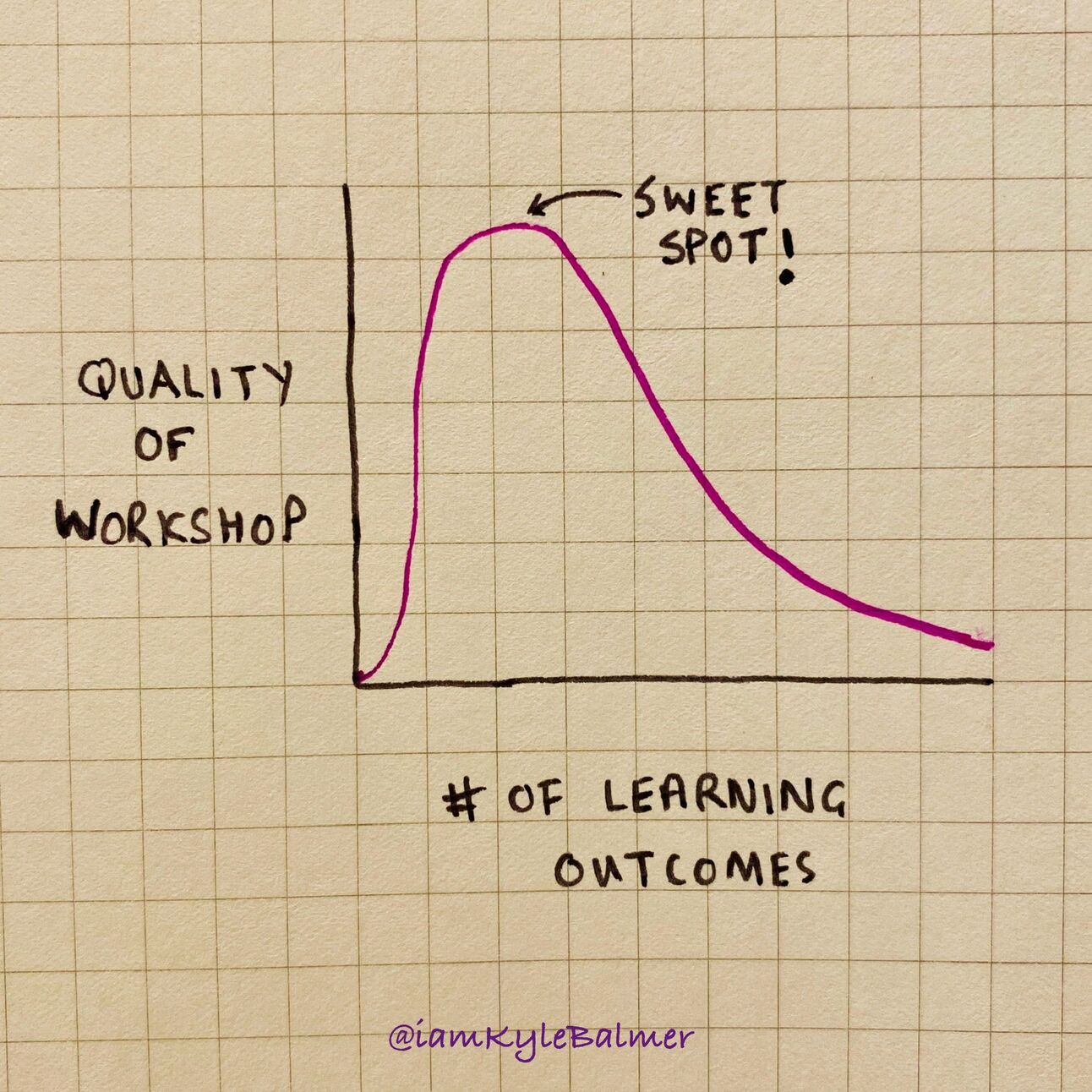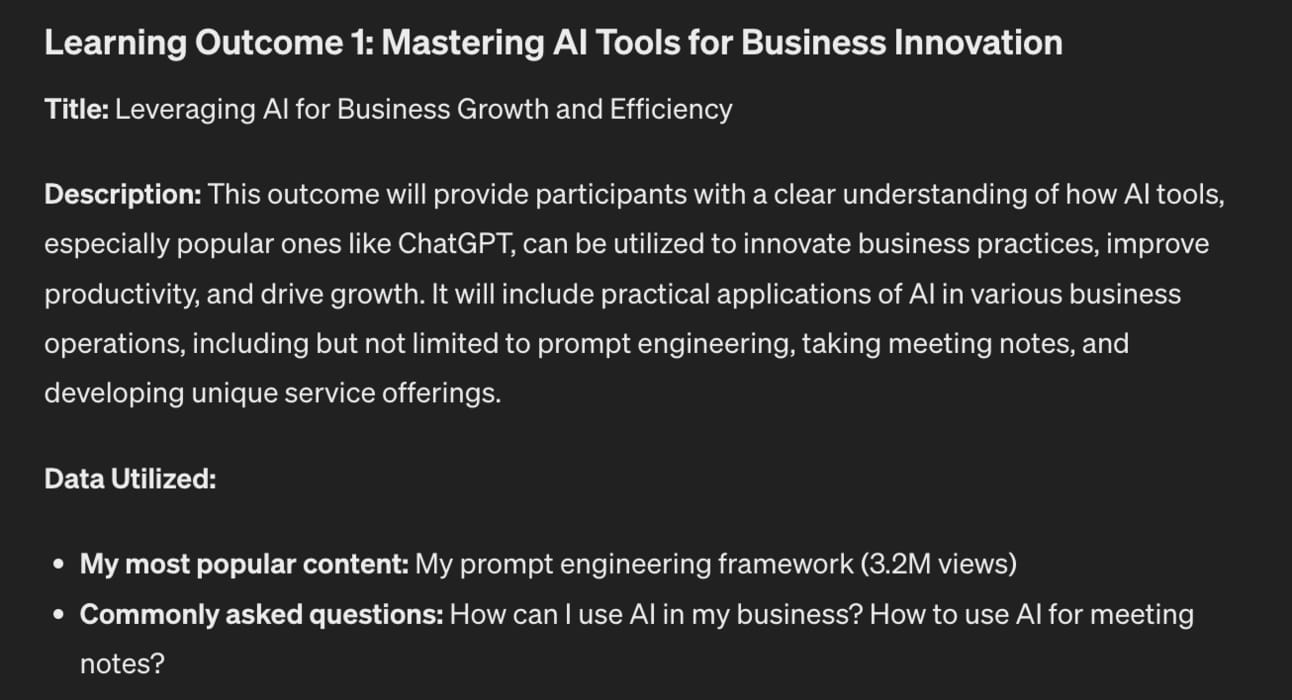Introduction
The most common mistake I’ve seen when attending workshops is that the expert speaker designs a workshop that they’d like to go to.
They are thinking “If I went to a workshop on such and such this is what I’d like to see covered”.
What they, as the expert, want is very different to what their audience want.
We’ll override this challenge and start constructing a workshop that customers will love.
Let’s get started:
What your workshop will be about
What your workshop will be about?
- Solve the most common problems your customers have
- Determine 2-3 learning outcomes
- Learn How to x : this is a how-to workshop, not a keynote presentation
When experts construct workshops thinking about what they’d want the workshops tend to suck.
These workshops will tend to pack in too much in too short a session. The facilitator will run into participants who need extra help to keep up. Extra time is needed to catch them up. The schedule slips. The facilitator starts to rush through content to “get it all in”. Energy and goodwill diminishes.
You’ve probably been to workshops like this. You come out of them feeling more confused than when you went in. A waste of time.
Instead we’re going to design our workshop:
- at a less advanced level
- covering a small handful of learning outcomes
- and focusing on making those small number of learning stick rather than simply adding more and more “content”
It’s going to be quality over quantity.

What should the workshop be about?
Later you can have more advanced workshops on advanced topics. For your first though keep it for a wide, beginner audience.
Why? Chances are the general knowledge level around your niche is much lower than you expect. You probably think the public know a lot about the topic but that’s because you are (likely) surrounded by a bubble of peers like you. They are also experts!
For example, one of my first workshops on ChatGPT I had to spend 30 minutes just getting people onto ChatGPT. They didn’t know if it was a software, something they had to download or some sort of website. Literally starting from zero.
So any content on prompt engineering, the best uses of AI in an organisation and custom GPTs is entirely pointless if people haven’t even logged into ChatGPT!
Your audience will be similar. They will know a lot less than you do.
What we want to do is find out the burning questions they they have about your topic.
There are a couple of ways to do this.
Existing Content
If you already do content marketing then the best method is to look at your most popular posts and videos. Chances are these will guide you towards valuable topics.
For example I have one video on TikTok with 3.2M views. It’s about the RISEN prompting framework. That goes in all my workshops and I’m often told it’s the most valuable component.
Let existing popularity guide what will be popular in the future.
Answer the Public
Use Google Ad data or (more simply) Answer the Public to look up commonly asked questions about your niche. These tools will tell you what topics and questions are already being asked.
Existing Courses and Content
If still stuck then look at courses about similar subjects to yours over on Udemy and other course platforms.
You can also look at the topic on Youtube for a broader approach. Basically you are looking for topics that consistently seem to do well, across multiple channels.
These methods are less useful than looking at your own audience data but still valid.
Learning Outcomes
From the most popular topics you want to carve our 2-3 learning objectives.
No more. Resist the urge.
For example in my basic AI for businesses workshop my learning objectives are:
- how to think about AI
- using AI is a communication skill
- the best (and worst) tasks to use AI on
That’s it.
One hour is not a long time and nailing 3 points well is far more powerful than 10 points poorly.
The workshops are structured around absolutely nailing these learning outcomes using a mixture of lecture, exercises , Q&A and other learning strategies. We’ll discuss all this in the next Part.
Right now you need to work out your 2-3 learning objectives.
We want to convert our popular content and common questions in our learning objectives.
I’d recommend grabbing pen and paper and working this out manually. It’s a very important exercise! The most important in fact.
But we can also use a prompt to get us started:
Act as a workshop creator
I need 3 learning outcomes for my 1 hour session.
Help me to define these learning outcomes by analysing this data: i) my most popular content ii) commonly asked questions and iii) existing popular third party content.
Prioritise my content above all in your analysis.
Combine the provided info in 3 coherent learning outcomes. For each write a title, description and outline what data is in each.
You do NOT need to use all the data. Create a 4th category for data that does not fit into the learning outcomes.
Data follows:
i) my most popular content
ii) commonly asked questions
iii) existing popular third party contentInto this I fed:
Data follows:
i) my most popular content
my prompt engineering framework (3.2M views)
which AI is best?
what's the best free AI?
ii) commonly asked questions
how can I use AI in my business?
Is AI hype?
ow to use AI for meeting notes?
is AI safe?
iii) existing popular third party content
how AI will change business
ChatGPT errors and how to fix them
how to make $10,000 a month using AI toolsAnd ChatGPT outputted detailed learning outcomes.
Here’s the first of three:

The prompt also has a “dump” category where it adds the topics that don’t fit in. This is handy otherwise ChatGPT will just stick these topics in an inappropriate place.
Use this only to get started thinking about your three learning outcomes. It’s a first pass so make sure to (as an expert) dig into this exercise in more detail.
Packaging it up
Once you have your three learning outcomes decided use this simple prompt:
Using these three learning outcomes
Devise a descriptive and marketable title and subtitle
Use "How to X" as the formatThis will combine the learning outcomes into a title for you.
I got:

That’s a perfectly good working title. We can (and should) adapt it once we have the rest of our workshop prepared. But for now that’ll do the trick.
In the next Part we’ll structure our workshop, converting learning objectives into the actual running order of the day.